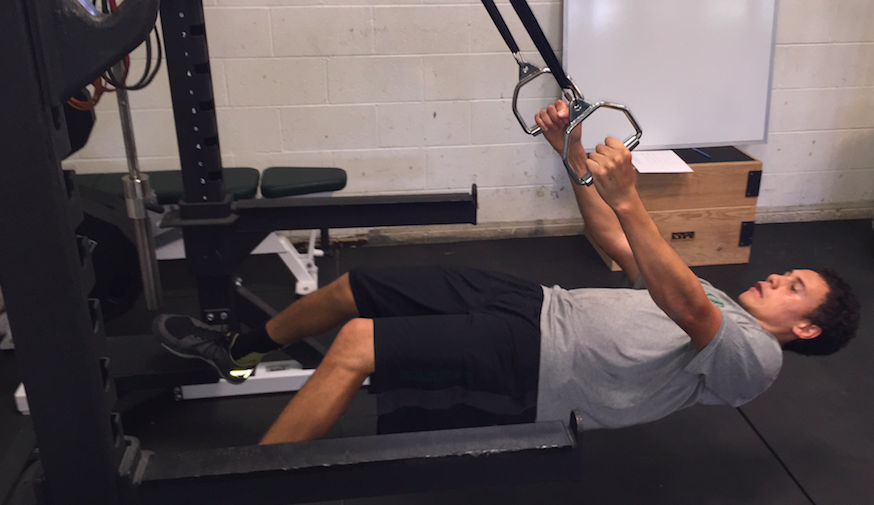Students set health and fitness goals before summer months
Christian Williams (12) trains in the gym off-season for football on Monday afternoon. As summer approaches, more students amp up health and fitness goals.
With summer rapidly approaching, the topic of staying skinny has resurfaced in popular media, leading to responses from Upper School students.
A private Facebook group, “Abs for Laguna,” created by seniors in preparation for the annual senior class trip to Laguna Beach in May, has gained popularity on campus, reflecting an increased concern about health and size on campus as well.
Daniela Lee (12), the starter of the group, believes that exercising is key to morale.
“It’s all for self-confidence, we want to feel good about ourselves and if our insides are working well our outsides will look beautiful, and we’ll be healthy,” Daniela said, specifying that health is the end goal, not becoming skinny.
The emphasis on fitness often triggers controversy when popular media equates beauty to physique. To Jessica Susai (9), although staying fit is important for one’s health, simply being slim is overrated.
“Today, in the media, ‘skinny’ is considered a lot more beautiful, which isn’t true at all,” Jessica said.
To combat the often media-set expectations a certain body shape, many organizations have started “Body Loving” campaigns, such as the Dove Real Beauty Campaign; however, the program is almost solely dedicated to “listening to women,” as their website states.
Both Daniela and Jessica point out that exercising is critical to staying healthy. In fact, fitness can stave off diseases, such as diabetes. According to the American Diabetes Association (ADA), a sedentary lifestyle combined with consumption of high levels of sugar can lead to Type II diabetes, a condition in which the pancreas cannot secrete enough insulin to stabilize blood glucose levels. The ADA reported in 2012 that 29.1 million Americans had diabetes, with 1.7 million new cases per year.
Obesity, which can is a common side effect of poor exercise and diet, affected 20.5 percent of youths between 12 and 19 years old in 2012, according to Centers of Disease Control and Prevention (CDC) report. The study classified an individual as obese when the person’s body mass index (BMI) fell in the 95th percentile of sex-specific CDC BMI-for-age growth charts.
Physically beneficial, exercise can also have key mental benefits. Basketball player Abhay Varmaraja (10) claimed that staying in shape through practice and offseason weight training improves self-esteem.
“[Working out] definitely improves [confidence],” Abhay said. “The fact that you can work out and lift weights helps you feel like you can do more. The social image just comes as a side benefit.”
Methods of staying fit vary among the students at the Upper School. While some students participate in school sports and activities to remain in condition, others exercise at the gym regularly.
Sophomore lacrosse player Alayna Richmond frequently integrates her team practice routine with frequent workouts at the gym.
Those surveyed believed that, while many pursue fitness for the social benefits, the health benefits are more meaningful.
“It’s not just about looking fit, but being fit and able to run really fast or [being] strong,” Samyu Yagati (12) said. “I exercise because it’s fun and it makes me feel more ‘chirpy.’ I eat healthy because it’s a good life habit.”
Counting calories has also become a popular trend in dieting and watching weight. Ashir Bansal (12) watches how many grams of protein, carbohydrates and fat he eats every day.
“I’m currently trying to lower my body fat [to watch his weight], so I’m working out, and I’m also eating a certain calorie intake a day,” he said. “I aim for about 2000 calories a day, which is 300 more than what I would eat just to survive.”
Processed foods, altered for convenience, can contain added sugars, salts and fat. Some students actively attempted to remove such foods from their diets. Soccer player Kedar Gupta (10) viewed staying healthy as a combination of sleep and diet.
“I’m sort of a naturalist in the sense that [I believe] you shouldn’t eat too much processed food or sleep super late because that’s not what your body’s used to,” Kedar said. “I feel like eating is only half the battle; it’s only one way to keep you healthy.”
Several students in the “Abs for Laguna” group recently adopted the military diet, a three day diet that claims to be “a fast way to lose up to 10 pounds a week,” according to its website. Its regimen details specific meals to eat for breakfast, lunch and dinner over the course of the three days. Exercising caution, they are trying the diet to shed some weight.
While the movement to slim down for summer carries social implications, another movement to encourage body positivity and exercise caution with dieting is catching steam.
This piece was originally published in the Winged Post on April 22nd.
Additional reporting by Maya Kumar.

Priscilla Pan is the features editor for the Winged Post and co-creator of In a Nutshell. She is a senior and has been part of the journalism program for...

Aditya Varshney (12) is the opinion editor of Harker Aquila and the Winged Post. This is his second year on staff. During his junior year, he occupied...

Vivek Bharadwaj (12) is the co-Editor-In-Chief for the Winged Post. His favorite subject in school is computer science, and he enjoys swimming and watching...


















![“[Building nerf blasters] became this outlet of creativity for me that hasn't been matched by anything else. The process [of] making a build complete to your desire is such a painstakingly difficult process, but I've had to learn from [the skills needed from] soldering to proper painting. There's so many different options for everything, if you think about it, it exists. The best part is [that] if it doesn't exist, you can build it yourself," Ishaan Parate said.](https://harkeraquila.com/wp-content/uploads/2022/08/DSC_8149-900x604.jpg)




![“When I came into high school, I was ready to be a follower. But DECA was a game changer for me. It helped me overcome my fear of public speaking, and it's played such a major role in who I've become today. To be able to successfully lead a chapter of 150 students, an officer team and be one of the upperclassmen I once really admired is something I'm [really] proud of,” Anvitha Tummala ('21) said.](https://harkeraquila.com/wp-content/uploads/2021/07/Screen-Shot-2021-07-25-at-9.50.05-AM-900x594.png)







![“I think getting up in the morning and having a sense of purpose [is exciting]. I think without a certain amount of drive, life is kind of obsolete and mundane, and I think having that every single day is what makes each day unique and kind of makes life exciting,” Neymika Jain (12) said.](https://harkeraquila.com/wp-content/uploads/2017/06/Screen-Shot-2017-06-03-at-4.54.16-PM.png)








![“My slogan is ‘slow feet, don’t eat, and I’m hungry.’ You need to run fast to get where you are–you aren't going to get those championships if you aren't fast,” Angel Cervantes (12) said. “I want to do well in school on my tests and in track and win championships for my team. I live by that, [and] I can do that anywhere: in the classroom or on the field.”](https://harkeraquila.com/wp-content/uploads/2018/06/DSC5146-900x601.jpg)
![“[Volleyball has] taught me how to fall correctly, and another thing it taught is that you don’t have to be the best at something to be good at it. If you just hit the ball in a smart way, then it still scores points and you’re good at it. You could be a background player and still make a much bigger impact on the team than you would think,” Anya Gert (’20) said.](https://harkeraquila.com/wp-content/uploads/2020/06/AnnaGert_JinTuan_HoHPhotoEdited-600x900.jpeg)

![“I'm not nearly there yet, but [my confidence has] definitely been getting better since I was pretty shy and timid coming into Harker my freshman year. I know that there's a lot of people that are really confident in what they do, and I really admire them. Everyone's so driven and that has really pushed me to kind of try to find my own place in high school and be more confident,” Alyssa Huang (’20) said.](https://harkeraquila.com/wp-content/uploads/2020/06/AlyssaHuang_EmilyChen_HoHPhoto-900x749.jpeg)



